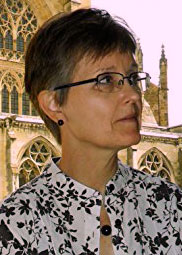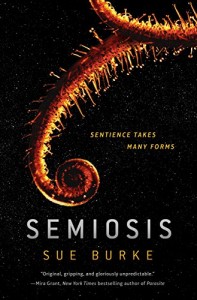 SFRevu: How did Semiosis come about? Did it spring from a short story? Did it come before or after your Clarion experience, and what did you think of that?
SFRevu: How did Semiosis come about? Did it spring from a short story? Did it come before or after your Clarion experience, and what did you think of that?
Sue Burke: It started with real life. A couple of my houseplants got into fights with other houseplants. A pothos wrapped around another plant and killed it, and a philodendron tried to sink its roots into a neighbor. That seemed suspicious, so I did some research and discovered that all plants in a given place are, as one botanist put it, “in a state of war with regard to each other.” (War on my windowsills!) That seemed like a good source of conflict for a story, but how?
Then I attended Clarion in 1996, and Gregory Frost, one of the instructors, gave us a writing prompt involving a wall separating two warring factions. I thought of a human colony appearing between two warring factions of plants. Based on that, I wrote a short story, which was published in the now-defunct magazine LC-39. A few years later, I reread that story and thought it could be expanded into a novel, so I did some more research and began writing.
Selling the novel was a long project with a lot of dead ends, but I never gave up, and finally I succeeded.
 SFRevu: The science in Semiosis seems quite solid. What did you use for sources for the idea of plant intelligences and the human neurobiology?
SFRevu: The science in Semiosis seems quite solid. What did you use for sources for the idea of plant intelligences and the human neurobiology?
Sue Burke: I have a shelf of books and research materials, in addition to online research. Four books I recommend: Life: A Natural History of the First Four Billion Years of Life on Earth, by Richard Fortey; The Rose’s Kiss: A Natural History of Flowers, by Peter Bernhardt; What a Plant Knows: A Field Guide to the Senses, by Daniel Chamovitz; and The Ants, by Bert Hölldobler and Edward O. Wilson. A Dictionary of Plant Sciences, edited by Jill Bailey, also helped, along with Worldbuilding, by Stephen L. Gillett.
SFRevu: The idea that language and the way people see the world are interrelated is well established, going back to one of my heroes of psycholinguistics, Benjamin Lee Whorf. How did that play out in Semiosis, and where has it shown up in your work translating Spanish to English?
Sue Burke: It shows up everywhere. Language and world view are deeply linked. I think the significant difference between languages isn’t what you can say. Nothing is untranslatable, although it may take a lot more words to say something in one language than another. Meaning can always be conveyed across languages and cultures with enough time and effort.
Languages differ in what you must say.
As a simple example, in Spanish, I must specify the way I address other people – two forms of “you,” either the familiar “tú” or the formal “usted.” I have to think about people in that way when I think in Spanish. I must also specify gender, for example either “el presidente” or “la presidenta” when talking about a head of state. When I translate, I have to compensate for that and other, more subtle differences, and make the English in the translation seem natural. Translators are schooled in a variety of techniques, and knowing when and how to apply them is the trick.
For plants, their life experience would give them different references from humans. A seed would mean something different to them, or sunshine, or sugar. I tried to weave that into the story.
In the end, though, it was hard to convey the depth of differences among languages without having to invest more time and effort into those differences than the narrative had time for. The language of Glassmade isn’t represented as being very divergent from English, but it would be in real life.
SFRevu: An early plot point that never seemed to get followed up on was that the colony ship’s AI wound up choosing a different system than the one they’d been shooting for. Was there any significance in that?
Sue Burke: I wanted to suggest that what happened was not ordained. Another story was possible. Perhaps a sequel? Or fan fiction?
SFRevu: Although Semiosis is your debut novel, you’ve published many short stories, including your story “Spiders” in the Hartwell/Cramer Year’s Best SF 14, which is set on the world in Semiosis. Are any of your stories available online, and do you have a bibliography?
- “Who Won the Battle of Arsia Mons” at Clarkesworld: http://clarkesworldmagazine.com/burke_11_17/
- “With Wings of Intent” at Every Day Fiction: https://everydayfiction.com/with-wings-of-intent-by-sue-burke/
- “Summer Home” at StarShipSofa podcast: http://www.starshipsofa.com/blog/2015/10/28/starshipsofa-no-408-ana-matronic-eric-james-stone-and-sue-burke/
- Another story set on the Semiosis world is at the novel’s website: https://semiosispax.com/2017/09/04/cinderella-faraway-a-short-story-set-between-chapters-1-and-2/
- The story “Spiders” is here: https://semiosispax.com/2017/09/04/spiders-a-short-story-set-between-chapters-3-and-4/
- Here’s a list of all my publications: https://sueburke.site/publications/
SFRevu: I don’t know anything about Spanish Science Fiction, but you’ve spoken highly of it, and of course you’ve translated a fair amount of it. Does it have any main themes, and where should I start to get to know it better.
Sue Burke: Science fiction is a worldwide conversation, so often science fiction in Spain and other countries is similar to what we write in the United States. Sometimes, however, it differs in the ways authors tell a story or in the setting. A story may be set locally in geography or mentality. The anthology Castles in Spain (Sportula, 2016), which I helped translate, includes a story about a flock of sheep in the apocalypse (there are lots of sheep in Spain), a ghostly boy at a plaza in the city of Cádiz, a ship captain (Spain is still a seafaring nation), or an alternate conquest of the Americas. But there are also stories that seem more like “mainstream” science fiction about Mars, cloning, and space exploration.
Speculative Fiction in Translation, a website by Rachel S. Cordasco, is a great place to start. http://www.sfintranslation.com/
SFRevu: Reading your blog posts at https://sueburke.site/ I was struck by the poetic quality of some of the writing, especially the post about making paper airplanes. I’m pretty sure you’ve written poetry as well, so can you point us towards some samples?
Thank you. I do write poetry, and there’s a little posted at http://sueburke.site. I hope to get more posted there soon. (I used to have a much bigger website, but it crashed, and now I’m building it up again.)
SFRevu: Who do you read now, and who did you read growing up? What drew you to science fiction?
Sue Burke: I read a lot of everything as a child, including science fiction. Like many SF fans, I liked the sense of wonder: the universe held endless, unpredictable adventures. I think science fiction also asks unique questions, especially about how to cope with change that occurs from outside our lives. In “literary” fiction, a change in character might be enough to solve a problem because the world remains basically under control. In science fiction, the problem may be too big to control, and maybe what you need to cope is a prosthesis or to become best buddies with an artificial intelligence.
My current reading is eclectic, basically all I have time for, which is never enough. One problem with being bilingual is that you have twice as many books you would love to read.
SFRevu: What other topics about science fiction or writing are you keen on?
Sue Burke: I’m interested in everything, which makes it hard to decide what book to read next. I’m particularly pleased with the development of ecopunk, considering how important ecology is in Semiosis. The world is changing fast, and science fiction gives us the tools to examine those changes.
SFRevu: The traditional last question: What are you working on? I know you’ve finished a sequel to Semiosis, so can you tell us anything about that and when it will be out? What other directions are you thinking of going?
Sue Burke: I don’t know if Tor wants to buy the sequel to Semiosis yet. I have a lot of ideas, though. In translation, a play by Miguel de Cervantes called Numantia has never been performed in English, and I’m trying to create a suitable version for stage. I’m also looking to branch out into historical fiction, specifically to tell the story of a medieval Spanish queen, Urraca, who led an army into war to keep her throne.
SFRevu: Sue, thanks very much.